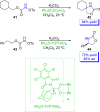Catalytic C-H functionalization by metal carbenoid and nitrenoid insertion
- PMID: 18216847
- PMCID: PMC3033428
- DOI: 10.1038/nature06485
Catalytic C-H functionalization by metal carbenoid and nitrenoid insertion
Abstract
Novel reactions that can selectively functionalize carbon-hydrogen bonds are of intense interest to the chemical community because they offer new strategic approaches for synthesis. A very promising 'carbon-hydrogen functionalization' method involves the insertion of metal carbenes and nitrenes into C-H bonds. This area has experienced considerable growth in the past decade, particularly in the area of enantioselective intermolecular reactions. Here we discuss several facets of these kinds of C-H functionalization reactions and provide a perspective on how this methodology has affected the synthesis of complex natural products and potential pharmaceutical agents.
Figures












References
-
- IMS Health Reports Global Pharmaceutical Market Grew 7.0 Percent in 2006 to $643Billion. 2007. http://www.imshealth.com/ims/portal/front/articleC/0,2777,6599_366 5_805....
-
- Lipinski C, Hopkins A. Navigating chemical space for biology and medicine. Nature. 2004;432:855–861. - PubMed
-
- King AO, Yasuda N. Palladium-Catalyzed Cross-Coupling Reactions in the Synthesis of Pharmaceuticals. Topics in Organometallic Chemistry. 2004;6:205–245.
-
- Nicolaou KC, et al. Synthesis of epothilones A and B in solid and solution phase. Nature. 1997;387:268–272. - PubMed
-
- Crabtree RH. A catalytic knight's move. Nature. 2006;441:165–166. - PubMed
Publication types
MeSH terms
Substances
Grants and funding
LinkOut - more resources
Full Text Sources
Other Literature Sources
Miscellaneous

